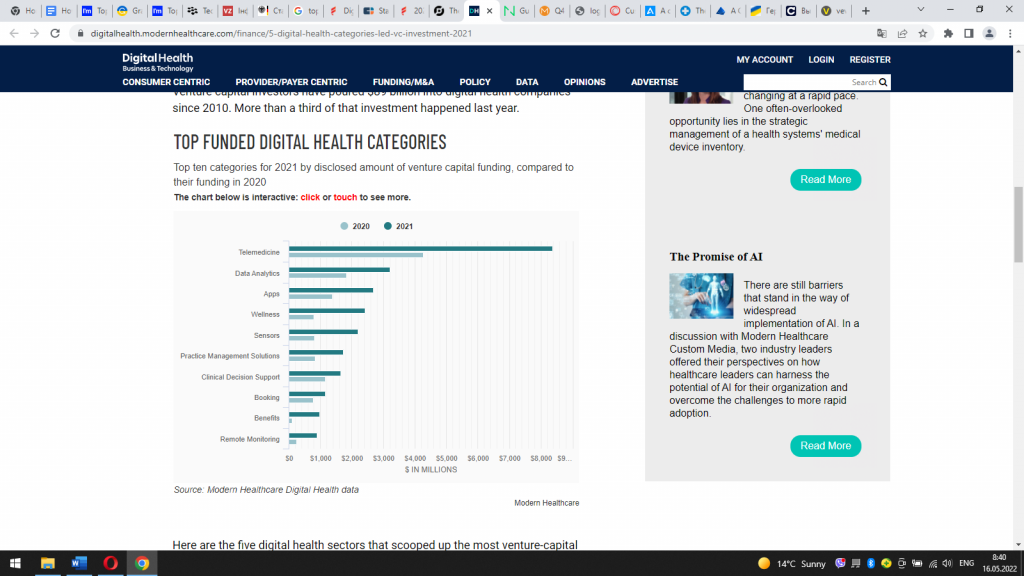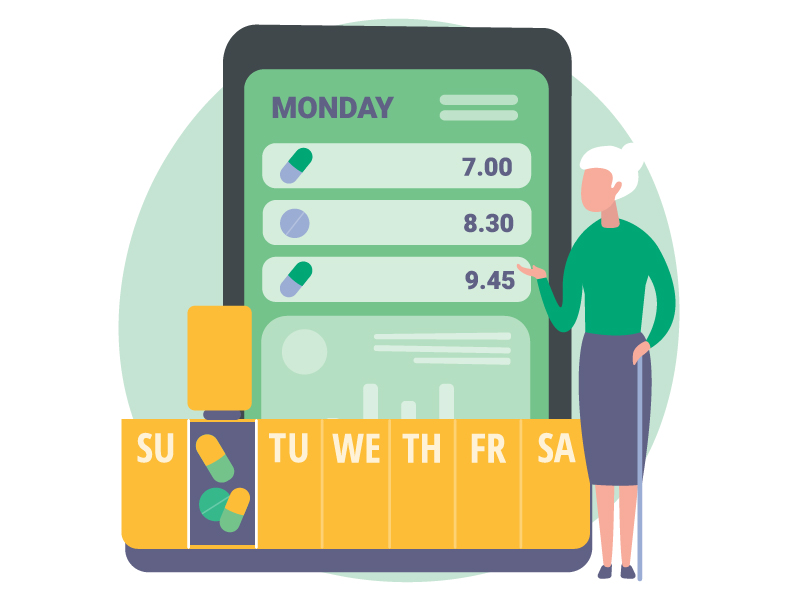With the advancement of technology and the changes in customer preferences, users seek the most convenient and safe access to medical services. Healthcare enterprises recognize the need to implement new digital healthcare initiatives to meet the emerging demands, hence the accelerated investments in software development for healthcare needs. The chart below demonstrates the record-breaking rise in digital health investment in 2021. Although the beginning of 2022 displayed a certain decrease, the aftermath of the pandemic and the rising role of digital technologies make it safe to assume that the positive investment trends will continue.
Digital Health Funding 2018 – Q1 2022

How should an organization approach the complex process of healthcare software development? The article outlines the basics of building an effective digital healthcare solution.
The Modern Healthcare Landscape: Technology and Statistics
Custom healthcare software development is paramount for paving the way for the future of the healthcare industry. Which techs will shape the sector within the next years?
- Healthcare technology solutions are expected to make a value of $350 billion–$410 billion by 2025.
- Artificial Intelligence and Machine Learning are going to reach about $190.6 billion by 2025.
- The telemedicine market is going to rise at a CAGR of 22.4% between 2021 and 2028.
- IoT and IoMT: The spending on IoT is expected to reach $534.3 billion in 2025. An emerging segment of IoT – the Internet of Medical Things – already promises to reach $158.1 billion by 2022.
- AR and VR implementation in the healthcare industry is anticipated to make $11.14 billion by 2025.
- The chatbots’ penetration into the healthcare sector is projected to exceed $498.1 million by 2029.
The Most Important Aspects of Developing Software for Healthcare
To properly plan the process of software development in healthcare, consider the following stages.

Analyze the market and the existing software
Start with assessing demand and checking your competitors. This will help you shape the vision of your strengths, weaknesses, and opportunities.
Besides, learn the existing types of software. Which solutions are most popular? Which features are demanded by patients and practitioners? The chart below demonstrates the top-funded categories in medical software.

Telemedicine was the category that received the most investment of above $8 billion in 2021, and also the one that displayed the highest investment growth. The closest followers include Data Analytics, Mobile Health Apps, Wellness Companies, and Sensors.
Identify your target audience
Continue your digital transformation strategy by defining what you wish to accomplish and for whom. What will your digital asset change for which part of the medical staff and how will it affect the practitioners’ engagement with patients?
If you are developing a consumer-facing health application, determine the customer personas. This approach is vital since every person has an individual and deeply personal health journey. Therefore, medical specialists should strive to raise their services to tailored healthcare experiences.
Ensure security
You will never overrate the value of security in healthcare software. The protection of data privacy and countering the cybersecurity risks are subjects to stringent regulation and should become your major concern.
Primarily, medical and healthcare software should comply with HIPAA (US) and GDPR (EU).
Further, healthcare communication should be encrypted according to the highest security standards. This guarantees data privacy protection and helps to build trustworthy relationships between caregivers and patients.
Facilitate your data processing
Data accumulation, processing, and management are much more than just administrative work. By increasing patients’ knowledge of how medical providers use their data, practitioners can enhance patients’ engagement in the treatment process, which consequently raises the treatment success rates. Moreover, technology-driven data processing allows for optimizing workflows and reducing costs.
Thus, Electronic Healthcare Records (EHRs) streamline the interactions between patients and doctors. EHRs extract information from multiple data sources and provide instant access to patient history, medications, and other significant factors, thereby enhancing the diagnosis setting. Combined with AI and IoMT, EMRs minimize the doctors’ time spent on collecting and analyzing data, allowing them to devote more time to the patients and treatments.
Keep scalability in mind
Be sure to make your digital asset scalable from the very start. If your software product delivers value, chances are that its audience will broaden in the long run. The illustrative example of such scaling is the growth of telehealth platforms during the pandemic. Because of the skyrocketing demand, these platforms not only increased their capacity but also added new features.
UX is vital
Healthcare applications should be convenient for both medical specialists and patients. While for the first group a great UX design means less routine work, for the latter it’s a bit more complicated. Patients’ physical, emotional, or financial condition may impede their abilities to explore new technologies. Therefore, the UX designers should meticulously study target users, their needs, and pain points to develop the most appropriate solutions. Thus, they may consider the specifics of senior users, access for patients with visual, auditory, and cognitive challenges, and other factors.
Interoperability is key to future success
Today, healthcare organizations broadly adopt IT systems based on cloud and analytics tools. Therefore, companies should seek interoperability of information and platforms.
In the technology age, more and more digital tools will appear over time. In order to counter the challenge of legacy systems integrations, medical institutions should design their core systems with interoperability in mind. For example, EHRs usually need to link with various kinds of medical software and relevant modules including financial systems and patient portals.
Leverage mobile apps
The overwhelming penetration of mobile devices dictates the way how users expect the services to be delivered. Healthcare is not an exception. Therefore, it makes sense for medical entities to empower their clients to get services through smartphones at the convenience of their homes or other preferred locations.
Mobile apps are extremely practical for patients and beneficial for doctors. They can be linked with wearable devices and allow collecting patient data, tracking progress, and receiving recommendations. As a result, mobile apps can enhance patient care and optimize work processes for medical staff.
Partner with an expert software developer
A proficient vendor can effectively lead you along the path of developing a stellar software solution. By guiding you through the development process, a qualified developer will help you understand the market, follow trends, align your goals, achieve scalability, and ultimately maximize your gains.
Summary
Digital transformation will help healthcare institutions to gain an edge over the competition and serve their clients in a more efficient manner. To painlessly adopt the new technologies, medical organizations should follow the most important steps of the software development process. Cooperating with an experienced developer will save you from the excessive hassle and guarantee a successful outcome. Let our qualified team help you meet your goals with the unrivaled custom software solution.



